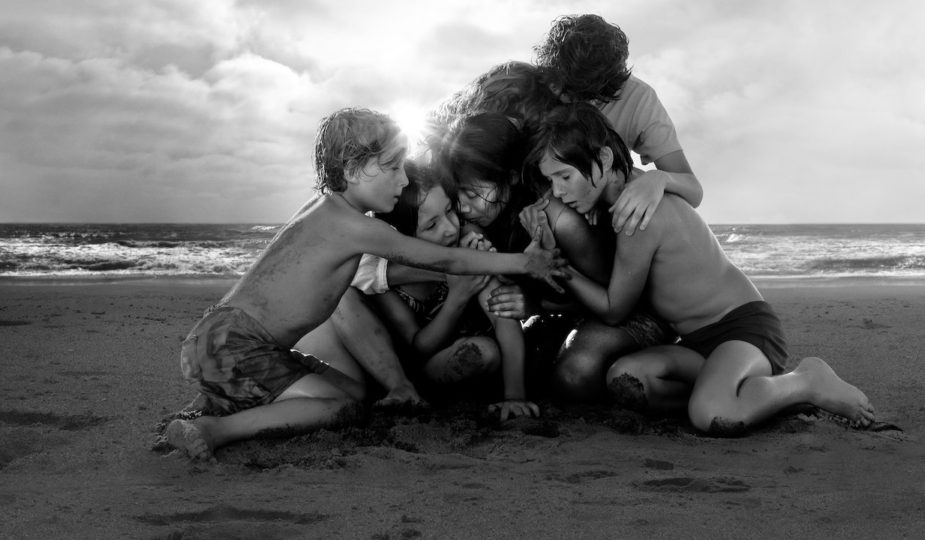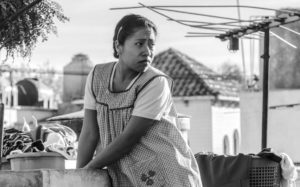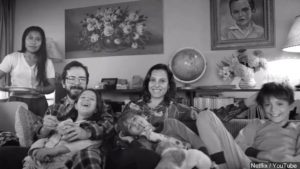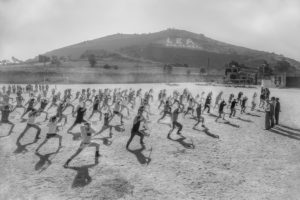
ROMA (2018)
Director: Alfonso Cuarón
Throughout the history of cinema, some of the most acclaimed directors have given in to the temptation of capturing their childhood memories on celluloid. That’s the case with François Truffaut and his The 400 Blows (1959), Ingmar Bergman with Fanny and Alexander (1982) or Federico Fellini with Amarcord (1973). In 2018, the renowned Mexican director Alfonso Cuarón decided that his time had come, and he brought his childhood remembrances to the big screen.
Alfonso Cuarón was born in Mexico City in 1961. He wanted to become a director or an astronaut, and he finally entered the world of cinema. He received his first camera at 12, and started to film everything around him. His passion for the seventh art was so great that sometimes he deceived his mother, telling her that he’d go to a friend’s house- as you might imagine, this was only an excuse to escape and watch movies at his local cinema. When he finished high school, Cuarón decided to study cinema at the Cinematographic Training Center, where he was rejected because of his young age. At that time, Cuarón’s mother didn’t support his film ambitions, so he decided to study Philosophy in the mornings, and in the afternoons he went to the Centro Universitario de Estudios Cinematográficos (CUEC).
Cuarón studied cinema and philosophy, and he didn’t finish none of them. In those dark moments of his life, he met Emmanuel “El Chivo” Lubezki, another genius of cinema who would become a good friend of Cuarón and work on many of his films. Currently, El Chivo is one of the world’s most acclaimed cinematographers, he was the director of photography in films like Malick’s The Tree Of Life (2011) and Iñárritu’s The Revenant (2015)
Another encounter was equally important for Cuarón: “Guillermo del Toro appeared later in my life. He is, like me, another worker of cinema. I was in charge of the sound’s pole, and I heard about a makeup genius in the city of Guadalajara, Mexico. Finally, we both met on a television series, called La Hora Marcada (1988). We crossed paths in a dressing room: ‘You are Del Toro’; ‘You are Cuarón’. Guillermo approached me and said: ‘You stole the story of Stephen King.’ I answered ‘Yes’, to which Del Toro added: ‘And why if King’s story was so good, your episode is so bad?’. That’s how we became friends.”
Alfonso Cuarón is now considered as one of the most important contemporary Mexican filmmakers along with Guillermo del Toro and Alejandro González Iñárritu. Throughout the years, he has crafted a unique, passionate and very ambitious style of filmmaking, which is often associated with gigantic landscapes and contemporary human catastrophes. Cuarón has captivated the world with films like Y tu mamá también (2001), Children of Men (2006) and Gravity (2013), among others.
ROMA (2018) wouldn’t be the same if it wasn’t for the marvelous lead actress Yalitza Aparicio. She was born in the humble town of Tlaxiaco, Oaxaca. At the time that Cuarón contacted Yalitza for the role, she lived a quiet and private life. Aparicio was a preschool teacher, with no aspirations of becoming a professional and widely acclaimed actress.
ROMA is the name of the district in Mexico City where Cuarón grew up. This is one of the city’s places where families live in privileged conditions and hire maids and drivers to maintain their living standards. In one of those  houses, Cleo (Yalitza Aparicio) works for a family that seems to be unable to live without her. In the morning, she wakes the children up and takes them to school, at night she takes them to bed. From dawn to dusk she works: she cleans, serves the food, cleans up the dog’s poo, takes the dirty clothes to the rooftop, etc. Cleo’s daily life is portrayed from her own points of view. Much of the film takes place inside the house which is a recreation of the home where Cuarón lived in his childhood years.
houses, Cleo (Yalitza Aparicio) works for a family that seems to be unable to live without her. In the morning, she wakes the children up and takes them to school, at night she takes them to bed. From dawn to dusk she works: she cleans, serves the food, cleans up the dog’s poo, takes the dirty clothes to the rooftop, etc. Cleo’s daily life is portrayed from her own points of view. Much of the film takes place inside the house which is a recreation of the home where Cuarón lived in his childhood years.
Cleo lives with the family’s cook Adela (Nancy García) in a small and narrow room of the house. They both come from the same town in the southern state of Oaxaca, Mexico. They communicate in Spanish and Mixteco (native language), share gossip and news from the house. The four children of the family – one girl and three boys, are a charming and lovable crowd. The father, Dr. Antonio (Fernando Grediaga) is constantly absent and absorbed by his work. The mother, Sofía (Marina de Tavira) is more  present in everyday life. Nevertheless, the children regard Cleo as their true maternal figure. The husband unfairly represses Sofía, and she in turn scolds Cleo. This situation becomes a chain of mistreatment that Cuarón masterfully represents through the camera’s scope.
present in everyday life. Nevertheless, the children regard Cleo as their true maternal figure. The husband unfairly represses Sofía, and she in turn scolds Cleo. This situation becomes a chain of mistreatment that Cuarón masterfully represents through the camera’s scope.
The film doesn’t have a solid or linear argument; there aren’t grand mysteries to be solved. Instead, Cuarón creates a realistic and detailed vision of Cleo’s world. The film also works as a love letter to Mexico City’s feelings, streets, corners and socio-political situations of that particular time.
A series of catastrophes crush the stabilities of this universe. The father takes a business trip from which he never returns. A massive earthquake shakes the city. Cleo’s unexpected pregnancy triggers a series of emotional moments, betrayals and deaths. In one of the most impressive sequences, Cleo and the family’s grandmother, Mrs. Teresa (Verónica García), watch a student demonstration through the window of a furniture store. This event turns into a violent confrontation with the police. Cuarón doesn’t explicitly reveal the origins of the historical incident known as El Halconazo or the Corpus Christi Massacre (1971).
Cuarón places the characters in the midst of important historical events in Mexico: the struggle of the people for the progress of the country and their opposition against a political and authoritarian regime that tried to maintain their privileges through various strategies. It is clearly exemplified in the film via the character of Fermín (Jorge Antonio Guerrero), which is Cleo’s “boyfriend”. Fermín belongs to the military group  called Los Halcones. At that time, high-ranking officials of the Mexican government secretly organized, financed, trained, and armed various groups, including Los Halcones. The main objective of the government was to stop the social movements of the late 1960s and early 1970s. Los Halcones were a group of approximately 2,000 young men, aged 18 to 29. The squad leaders were middle-class college students whom (in exchange for their participation in the group) received scholarships, weekly pays and the promise of a bright future inside the corrupt ruling party, the Partido Revolucionario Institucional (PRI). Armed with bamboo sticks and rifles, Los Halcones attacked the protesters and caused the second bloodiest event in modern Mexican history (known as El Halconazo), which was only surpassed by The Tlatelolco Massacre (1968).
called Los Halcones. At that time, high-ranking officials of the Mexican government secretly organized, financed, trained, and armed various groups, including Los Halcones. The main objective of the government was to stop the social movements of the late 1960s and early 1970s. Los Halcones were a group of approximately 2,000 young men, aged 18 to 29. The squad leaders were middle-class college students whom (in exchange for their participation in the group) received scholarships, weekly pays and the promise of a bright future inside the corrupt ruling party, the Partido Revolucionario Institucional (PRI). Armed with bamboo sticks and rifles, Los Halcones attacked the protesters and caused the second bloodiest event in modern Mexican history (known as El Halconazo), which was only surpassed by The Tlatelolco Massacre (1968).
Mexico keeps dragging the same problems of corruption, impunity, insecurity, and inequality. Those are the horsemen of the apocalypse that constantly devastate the country. These specific elements of ROMA bears parallels to the masterful Mexican movie Los Olvidados (1950), directed by Luis Buñuel.
The emblematic climax of the film is represented by a hug of the four children and Sofia with Cleo, among the rough waves of Tuxpan, Veracruz- a sequence that is both terrifying and overwhelming. More than a hug, this is the tree that represents the strength and love of the Mexican family. In any case, we shouldn’t forget that ROMA is especially dedicated to Liboria Rodríguez “Libo”, the woman who raised the director since he was a little boy. We can find many women like “Libo” in any corner of the country: a humble, noble, maternal woman who is a constant victim of machismo and socio-economic abuses. Cuarón doesn’t forget about these women and pays hommage to them in the film, and most importantly- he doesn’t make any feminist speeches or judges, but the facts speak for themselves. In Cuarón’s words:
“When you strip hope from people, it leaves a void, and that void needs to be filled. And very likely, that void is going to be filled by an ideology… Hope and faith are so connected. Now, when ideology connects with faith, the ideology becomes an item of faith, not a point of discussion.”
by Octavio Carbajal González

Octavio,
Another complex, in-depth, reflective review from you. You have such profound perceptions on film.
Alfonso Cuaron’s Roma is a heartfelt and sad story that touches on many issues in Mexico during the 1970s, including absent fathers, divorce, and political violence.
Yet the audience only sees Cleo as the family’s maid. Cleo’s own indigenous life is missing. This would have deeply enriched the film.
Thank you so much for your words of encouragement, Mark.
ROMA is a really remarkable film, recently added to the Criterion Collection.
The stunning cinematography and Yalitza’s marvelous performance are the main pillars of the film. I’m satisfied with Cleo’s visual perspective of this universe.
There are some bone-chilling scenes where the camera revolves all the way around, showing us the totality of the world that has been created. There’s a “forest fire” sequence that left me completely speechless, it reminded me of Tarkovsky’s “Andrei Rublev” (one of your favorite movies).
This is a very personal story with an extraordinary technical courage…
Epic film. Thanks for the review, I need to explore this director’s filmography.
Very well written review! Interesting to see how filmmakers portray their own lives on screen. I recently saw Roma for the first time and absolutely loved everything from the cinematography in black & white to the main character and some of the most emotional scenes involving her. Great job! 🙂
Thank you so much for your lovely words, Fiona.
Alfonso´s words about ROMA: “It´s a film about a family, a city and a country; but ultimately is about humanity. I wanted to make a film that was both intimate and universal, a film that speaks to everyone.”
I´m glad that you enjoyed this unforgettable experience 😊
Octavio,
Another in-depth, reflective review from you. You have such profound perceptions of film.
Alfonso Cuaron’s Roma is a heartfelt and sad story that touches on many issues in Mexico during the 1970s, such as absent fathers, divorce, and political violence.
Yet the audience only sees Cleo as the family’s maid. Clegg’s own indigenous life is missing. This would have deeply enriched the film.
I always know that I’ve read something sincere and important when I want to know even more about the subject matter after I’m finished. Life is like that, I guess. We just keep learning more as we continue the conversation between each other.
Octavio, this is an extraordinary piece of work. The portrait you paint of the individual characters that maintain their dignity as they fight against the inherent oppression working against them is inspiring. True oppression that comes at people from every aspect of life. Even from those who claim to me with us. Your article is so much more than a review. It’s a statement about the dignity of Mexico. By showing us how the director weaves in aspects of his own life throughout the film, the reader feels the very real struggle happening every day. That humble nobility is desperately missing from so many individuals in western society. Particularly in the US, where we seem so determined to reward the very opposite. Thank you, my friend.
You always bring waves of exciting thoughts and reflections, Shawn.
First, thank you for taking the time to read, analyze, and enrich this special article. I feel very grateful and flattered with your words, my friend.
There´s always something new and exciting to learn from another cultures around the world. But, some historical events are often overshadowed by the ones that Saliha points out in her comment. Once you get immersed in these kind of unknown stories/facts, your own universe opens up a new perspective about an specific country.
We can find all the good and bad parts of existence inside this film. Even in the most darkest moments, you feel some kind of strange energy that makes you want to keep going. Cleo´s actions and gestures are a monument to kindness. As you said, most of these individual characters are fighting against an oppressive atmosphere that is constantly trying to crush their dignities. I wanted to capture the essential pillar of Mexico´s feelings (both emotionally and politically). It seems that I achieved my goal.
When ROMA gets to the ending credits, you regain hope and faith in humanity.
Great review my friend! I also love how Cuaron and del Toro became friends.
Im glad you mentioned how the women in his life infuenced this epic movie.
Will have to watch this again now!
Bravo!
You´ve been supporting my reviews for a long time, Serge. I truly appreciate your kind words and points of view. The film requires multiple viewings. Glad you enjoyed my article !.
The film was a bit too slow for my viewing habits, but a magnificent tearjerker. Incredible photography in this film!
It might seem difficult to get inside the film´s universe (especially if you´re not Mexican). Anyway, I´m glad you liked the movie !
Roma has such a sublime and contemplative quality to it…Rare are those movies where the viewer ceases to be the viewer, and becomes a part of the world the Director creates. I enjoyed Roma thoroughly, once I surrendered to its world, and then I was right there, with Cuarón, witnessing his childhood memories. Roma is thus, a testament to Cuarón’s masterful ability to create great cinematic experiences. Roma is also not all melancholy…it finds hope and humor in the unexpected and bizarre moments of Cleo’s life – Thinking of Professor Zovek and her endearing bond with Pepe.
Thanks Octavio for an eloquent and well-thought out writing (as always).
I’m very grateful with your comment, Swaha. Yes, this is the rare film where the viewer is immediately absorbed by the director’s own universe. Cuarón preserved the authenticity of his own origins. He filmed on the same street where he grew up, the school where “Libo” picked him up everyday, etc. Every location in the film was either the original place from his memory or an extremely detailed reproduction. In one scene, he recreated five blocks of Mexico City (exactly as it looked in 1970).
Oh, I’m so glad that you mentioned Professor Zovek (The Mexican Houdini). Such a peculiar character.. he captivated the Mexican public with his escapists acts and mental abilities. Some sources pointed that he was directly involved in “El Halconazo” , but this hasn’t been entirely confirmed (his family said that Zovek had nothing to do with this event). In the movie, he appears on TV and makes a “surprise visit” to the place where “Los Halcones” trained.
I’ll never forget Cleo’s endearing bond with Pepe, that connection is incredibly heartwarming.
You have interesting points of view!.
So dreamy ❤️
Not a movie, but an event. Sensitive, poetic, atmospheric in impressive black and white. Great review!
Thank you for taking the time to read!.
I completely agree with you. This is an event, a memory, a poem to Mexico. Cuarón crafted an unforgettable experience.
What a director and film, absolute masterpiece!
Those are words of wisdom, Michael.
You capture the essence of this very special film wonderfully. It’s a poetic, harsh, heartbreaking but also very tender and realistic film, I’ve never seen anything like it, both on the level of technical perfection and the emotions that it evokes. It’s no easy film but so perfectly blends magic and brutality, a magic realism without any exaggeration. The scene at the beach is unforgettable, as are other compositions like the fighters choreography. Cleo is in the center of it all as you rightly say- an entire life and its emotions in a film, I didn’t think that this was possible, only poetry can do that usually. Cuaron does the impossible here, and not just with having poetic ‘moments’, but having done an entire film which at every minute moves along poetic lines.
I love it how you teach us about the Mexican directors and cinematographers. These names- Alfonso Cuaron, Guillermo del Torro, Inárritu and Lubezki are legends, just look at their list of films- so many masterpieces among them- and yet people don’t know or remember their names or act funny when saying them, because they’re not called ‘Smith’ or Miller’ . So thanks for reminding us of what giants of cinema are coming from Mexico, and not just since recently…
It’s also great that you touch on the true historical events and give us a background here, people need to realize know that the world history doesn’t start and end with the 2 World Wars, Vietnam and 9/11. Coincedentally, I am writing quite a bit about Mexico in my next article coming soon, stay tuned. You perfectly describe the horsemen of the apocalypse for every society and you have a wonderful ending with Cuarón’s quote.
Thank you for picking this film and writing wonderfully about it, just looking at that picture tears up your eyes.
I had the pleasure to watch this film at my local cinema. As you might imagine, it was an otherwordly experience…
“A magic realism without exaggeration”- wonderful point of view. The technical/emotional aspects of the film are perfectly balanced. As you said, the entire film moves among poetic lines. Cuarón did a truly remarkable achievement.
In my childhood years, I used to walk with my mother through all the different districts of Mexico City, Roma was one of them. The house where this movie was filmed is just 30 minutes from my place.
I agree with you, Mexico has stunning talents in the seventh art, “Los Tres Amigos” (Cuarón, Del Toro, and Iñárritu) have revolutionized Mexican cinema.
I’m looking forward to your next article!..
Octavio Paz´s literary masterpiece “The Labyrinth of Solitude” sets the background and undertones of ROMA´s universe: the abandonment of the father, the wife’s suffering, the disappointment of the children. All these facts specifically refer back to an unsolved trauma: the Spanish conquest of the Aztec Empire. The historical events have a significant influence on the feelings of pessimism that prevail in Mexican´s way of thinking.
On the cinematic aspects, Cuarón said: “I would refrain from that classic, stylized look with long shadows and high contrast, and go into a more naturalistic black-and-white. “I didn’t want to try to hide digital in a ‘cinematic’ look but rather explore a digital look and embrace the present.”
The soundtrack also deserves a brief mention… The subtle songs come from “XEW” (famous Mexican radio station of the 1970´s). There are some gems by José José, Javier Solís, Rigo Tovar, Rocío Durcal, among others.
Anyway, thanks for your beautiful and inspiring words. Mexico’s ultimate love letter is now on VW. I couldn’t be happier!
What a film! Takes a while to settle into the rhythms of it, but boy is the reward high. Fantastic review mate, I already want to see the film again! Pure magic!
Thanks for your kind words, Phillip.
That’s true. Sooner or later, you are completely absorbed by the film’s phenomenal atmosphere. It’s a highly rewarding masterpiece. You should watch it again 😊